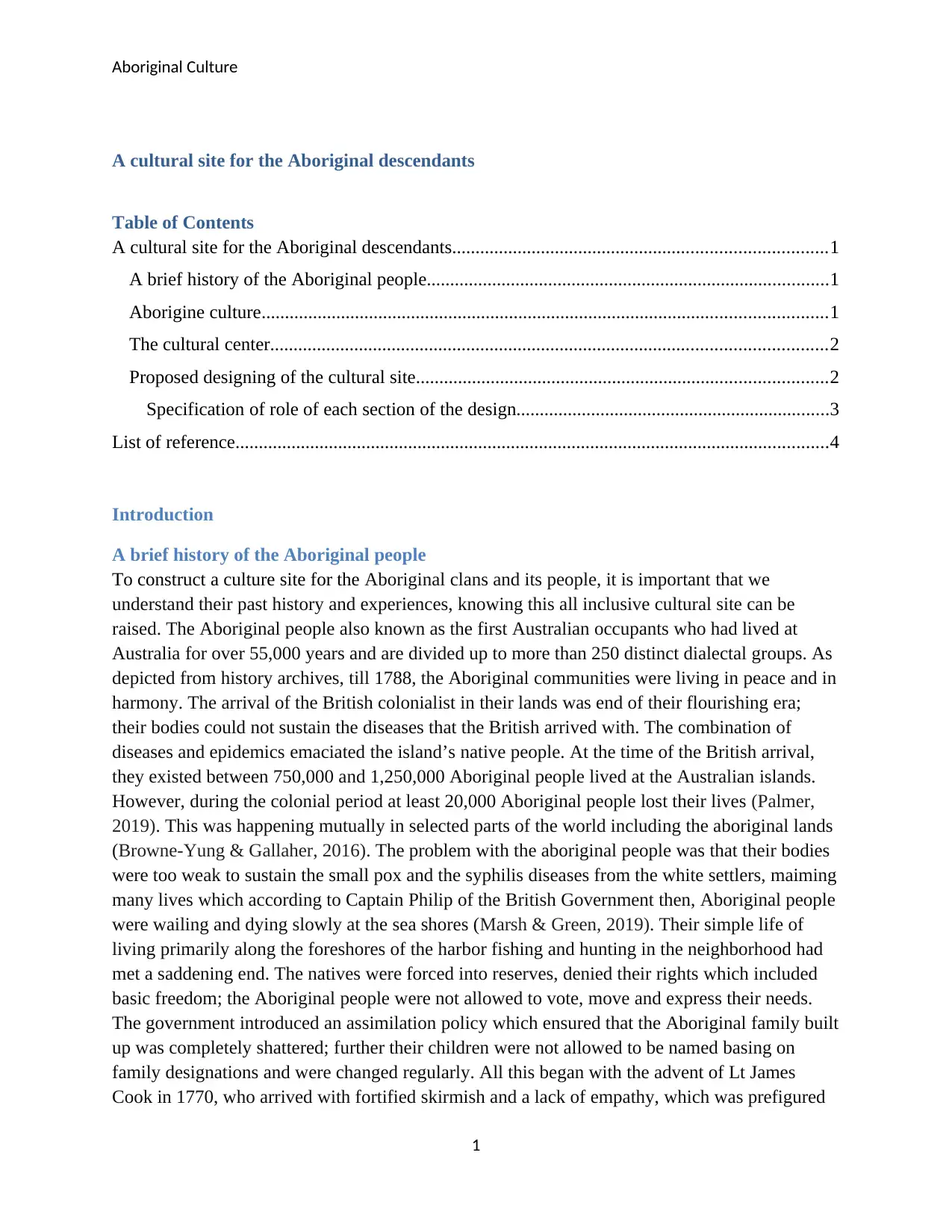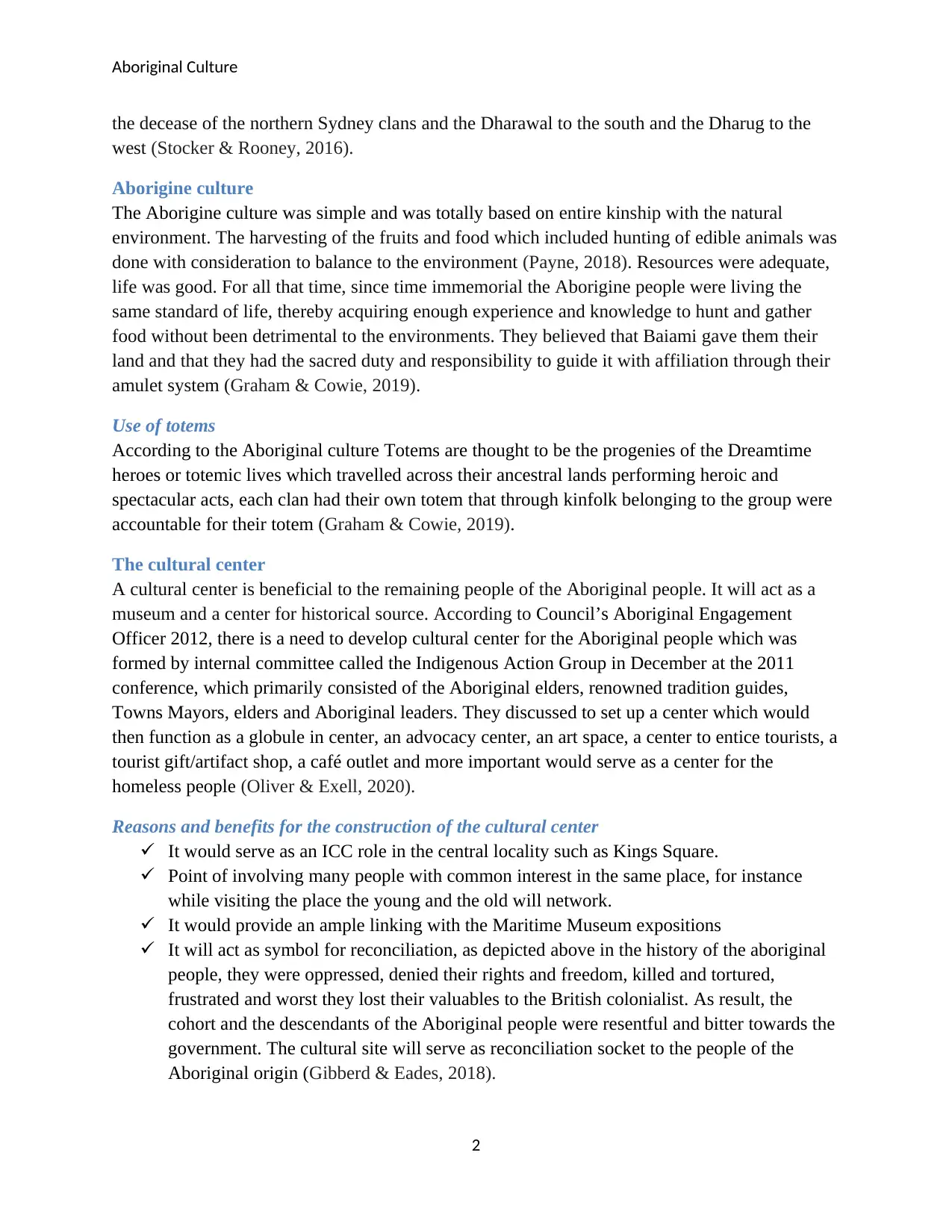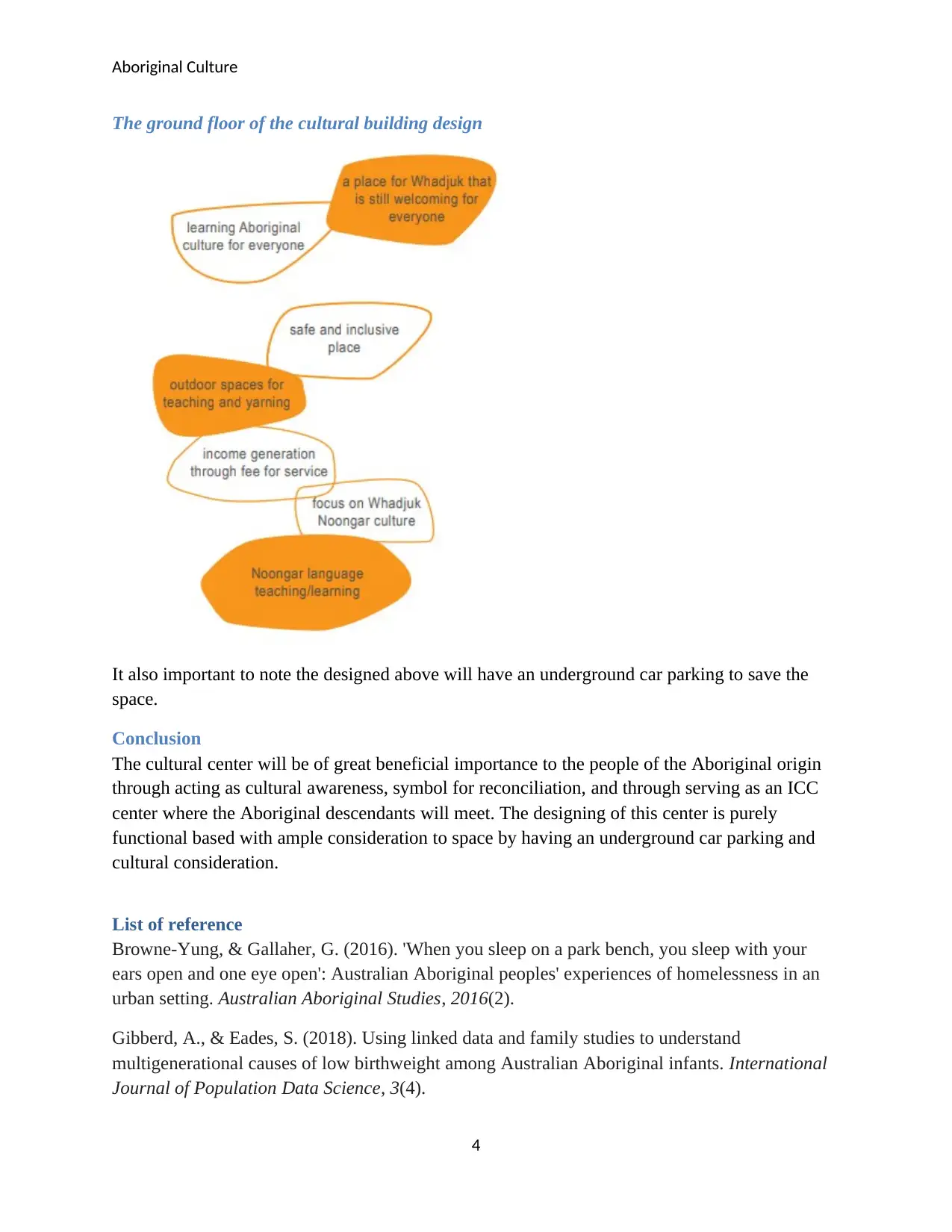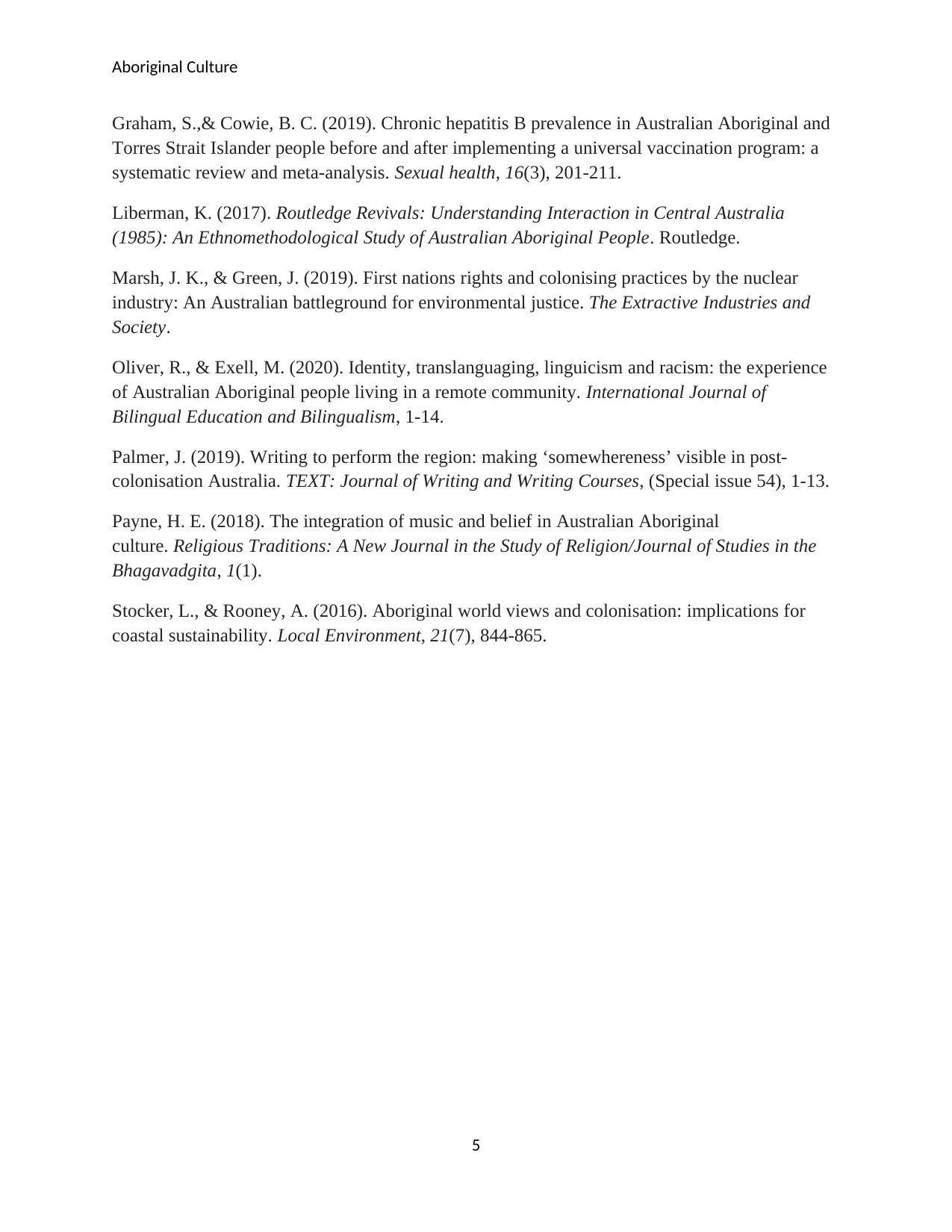Cultural Centre Design Report for Aboriginal Community at Waratah Park
VerifiedAdded on 2022/08/12
|5
|1947
|368
Report
AI Summary
This report focuses on the design and development of a cultural center at Waratah Park, formerly home to Skippy the Bush Kangaroo, to serve the Aboriginal community. The report begins with a brief history of the Aboriginal people and their culture. It then details the proposed design of the center, including a ground floor with a main hall for art and crafts, a theater for Skippy episodes, and a gift shop, and a first floor with managerial offices and a conference room. The report emphasizes the center's role in cultural awareness, reconciliation, and community engagement. The design incorporates underground parking and functional sections for welcoming visitors, education, language learning, income-generating activities, and art/craft activities. The report outlines the benefits of the center, including its function as an ICC center and a symbol of reconciliation. It also discusses the importance of involving the Aboriginal community in the center's operation and the educational displays that will showcase cultural heritage and biodiversity. The report concludes by emphasizing the cultural center's significance to the Aboriginal people.

Aboriginal Culture
A cultural site for the Aboriginal descendants
Table of Contents
A cultural site for the Aboriginal descendants................................................................................1
A brief history of the Aboriginal people......................................................................................1
Aborigine culture.........................................................................................................................1
The cultural center.......................................................................................................................2
Proposed designing of the cultural site........................................................................................2
Specification of role of each section of the design...................................................................3
List of reference...............................................................................................................................4
Introduction
A brief history of the Aboriginal people
To construct a culture site for the Aboriginal clans and its people, it is important that we
understand their past history and experiences, knowing this all inclusive cultural site can be
raised. The Aboriginal people also known as the first Australian occupants who had lived at
Australia for over 55,000 years and are divided up to more than 250 distinct dialectal groups. As
depicted from history archives, till 1788, the Aboriginal communities were living in peace and in
harmony. The arrival of the British colonialist in their lands was end of their flourishing era;
their bodies could not sustain the diseases that the British arrived with. The combination of
diseases and epidemics emaciated the island’s native people. At the time of the British arrival,
they existed between 750,000 and 1,250,000 Aboriginal people lived at the Australian islands.
However, during the colonial period at least 20,000 Aboriginal people lost their lives (Palmer,
2019). This was happening mutually in selected parts of the world including the aboriginal lands
(Browne-Yung & Gallaher, 2016). The problem with the aboriginal people was that their bodies
were too weak to sustain the small pox and the syphilis diseases from the white settlers, maiming
many lives which according to Captain Philip of the British Government then, Aboriginal people
were wailing and dying slowly at the sea shores (Marsh & Green, 2019). Their simple life of
living primarily along the foreshores of the harbor fishing and hunting in the neighborhood had
met a saddening end. The natives were forced into reserves, denied their rights which included
basic freedom; the Aboriginal people were not allowed to vote, move and express their needs.
The government introduced an assimilation policy which ensured that the Aboriginal family built
up was completely shattered; further their children were not allowed to be named basing on
family designations and were changed regularly. All this began with the advent of Lt James
Cook in 1770, who arrived with fortified skirmish and a lack of empathy, which was prefigured
1
A cultural site for the Aboriginal descendants
Table of Contents
A cultural site for the Aboriginal descendants................................................................................1
A brief history of the Aboriginal people......................................................................................1
Aborigine culture.........................................................................................................................1
The cultural center.......................................................................................................................2
Proposed designing of the cultural site........................................................................................2
Specification of role of each section of the design...................................................................3
List of reference...............................................................................................................................4
Introduction
A brief history of the Aboriginal people
To construct a culture site for the Aboriginal clans and its people, it is important that we
understand their past history and experiences, knowing this all inclusive cultural site can be
raised. The Aboriginal people also known as the first Australian occupants who had lived at
Australia for over 55,000 years and are divided up to more than 250 distinct dialectal groups. As
depicted from history archives, till 1788, the Aboriginal communities were living in peace and in
harmony. The arrival of the British colonialist in their lands was end of their flourishing era;
their bodies could not sustain the diseases that the British arrived with. The combination of
diseases and epidemics emaciated the island’s native people. At the time of the British arrival,
they existed between 750,000 and 1,250,000 Aboriginal people lived at the Australian islands.
However, during the colonial period at least 20,000 Aboriginal people lost their lives (Palmer,
2019). This was happening mutually in selected parts of the world including the aboriginal lands
(Browne-Yung & Gallaher, 2016). The problem with the aboriginal people was that their bodies
were too weak to sustain the small pox and the syphilis diseases from the white settlers, maiming
many lives which according to Captain Philip of the British Government then, Aboriginal people
were wailing and dying slowly at the sea shores (Marsh & Green, 2019). Their simple life of
living primarily along the foreshores of the harbor fishing and hunting in the neighborhood had
met a saddening end. The natives were forced into reserves, denied their rights which included
basic freedom; the Aboriginal people were not allowed to vote, move and express their needs.
The government introduced an assimilation policy which ensured that the Aboriginal family built
up was completely shattered; further their children were not allowed to be named basing on
family designations and were changed regularly. All this began with the advent of Lt James
Cook in 1770, who arrived with fortified skirmish and a lack of empathy, which was prefigured
1
Paraphrase This Document
Need a fresh take? Get an instant paraphrase of this document with our AI Paraphraser

Aboriginal Culture
the decease of the northern Sydney clans and the Dharawal to the south and the Dharug to the
west (Stocker & Rooney, 2016).
Aborigine culture
The Aborigine culture was simple and was totally based on entire kinship with the natural
environment. The harvesting of the fruits and food which included hunting of edible animals was
done with consideration to balance to the environment (Payne, 2018). Resources were adequate,
life was good. For all that time, since time immemorial the Aborigine people were living the
same standard of life, thereby acquiring enough experience and knowledge to hunt and gather
food without been detrimental to the environments. They believed that Baiami gave them their
land and that they had the sacred duty and responsibility to guide it with affiliation through their
amulet system (Graham & Cowie, 2019).
Use of totems
According to the Aboriginal culture Totems are thought to be the progenies of the Dreamtime
heroes or totemic lives which travelled across their ancestral lands performing heroic and
spectacular acts, each clan had their own totem that through kinfolk belonging to the group were
accountable for their totem (Graham & Cowie, 2019).
The cultural center
A cultural center is beneficial to the remaining people of the Aboriginal people. It will act as a
museum and a center for historical source. According to Council’s Aboriginal Engagement
Officer 2012, there is a need to develop cultural center for the Aboriginal people which was
formed by internal committee called the Indigenous Action Group in December at the 2011
conference, which primarily consisted of the Aboriginal elders, renowned tradition guides,
Towns Mayors, elders and Aboriginal leaders. They discussed to set up a center which would
then function as a globule in center, an advocacy center, an art space, a center to entice tourists, a
tourist gift/artifact shop, a café outlet and more important would serve as a center for the
homeless people (Oliver & Exell, 2020).
Reasons and benefits for the construction of the cultural center
It would serve as an ICC role in the central locality such as Kings Square.
Point of involving many people with common interest in the same place, for instance
while visiting the place the young and the old will network.
It would provide an ample linking with the Maritime Museum expositions
It will act as symbol for reconciliation, as depicted above in the history of the aboriginal
people, they were oppressed, denied their rights and freedom, killed and tortured,
frustrated and worst they lost their valuables to the British colonialist. As result, the
cohort and the descendants of the Aboriginal people were resentful and bitter towards the
government. The cultural site will serve as reconciliation socket to the people of the
Aboriginal origin (Gibberd & Eades, 2018).
2
the decease of the northern Sydney clans and the Dharawal to the south and the Dharug to the
west (Stocker & Rooney, 2016).
Aborigine culture
The Aborigine culture was simple and was totally based on entire kinship with the natural
environment. The harvesting of the fruits and food which included hunting of edible animals was
done with consideration to balance to the environment (Payne, 2018). Resources were adequate,
life was good. For all that time, since time immemorial the Aborigine people were living the
same standard of life, thereby acquiring enough experience and knowledge to hunt and gather
food without been detrimental to the environments. They believed that Baiami gave them their
land and that they had the sacred duty and responsibility to guide it with affiliation through their
amulet system (Graham & Cowie, 2019).
Use of totems
According to the Aboriginal culture Totems are thought to be the progenies of the Dreamtime
heroes or totemic lives which travelled across their ancestral lands performing heroic and
spectacular acts, each clan had their own totem that through kinfolk belonging to the group were
accountable for their totem (Graham & Cowie, 2019).
The cultural center
A cultural center is beneficial to the remaining people of the Aboriginal people. It will act as a
museum and a center for historical source. According to Council’s Aboriginal Engagement
Officer 2012, there is a need to develop cultural center for the Aboriginal people which was
formed by internal committee called the Indigenous Action Group in December at the 2011
conference, which primarily consisted of the Aboriginal elders, renowned tradition guides,
Towns Mayors, elders and Aboriginal leaders. They discussed to set up a center which would
then function as a globule in center, an advocacy center, an art space, a center to entice tourists, a
tourist gift/artifact shop, a café outlet and more important would serve as a center for the
homeless people (Oliver & Exell, 2020).
Reasons and benefits for the construction of the cultural center
It would serve as an ICC role in the central locality such as Kings Square.
Point of involving many people with common interest in the same place, for instance
while visiting the place the young and the old will network.
It would provide an ample linking with the Maritime Museum expositions
It will act as symbol for reconciliation, as depicted above in the history of the aboriginal
people, they were oppressed, denied their rights and freedom, killed and tortured,
frustrated and worst they lost their valuables to the British colonialist. As result, the
cohort and the descendants of the Aboriginal people were resentful and bitter towards the
government. The cultural site will serve as reconciliation socket to the people of the
Aboriginal origin (Gibberd & Eades, 2018).
2

Aboriginal Culture
It will serve as cultural awareness, where the descendants of the Aboriginal people will
visit the place to remind themselves of their ancestral livelihood. The exclusion of the
aboriginal people from practicing their cultures by the British, denied the practice of the
aboriginal cultures (Liberman, 2017).
Proposed designing of the cultural site
Ideally the building for the cultural site is premeditated to have two floors, the first floor and the
ground floor. Here the ground floor is the most important floor of the building and is anticipated
to host nearly 80% of the cultural heritage, which includes the Whadjuk for welcoming and
receiving the cultural site visitors, a room for erudition of the Aboriginal philosophy, teaching
the Noongar language, income generating activities, a hall which serves as a small theatre to play
skippy the kangaroo episodes and towards the exit to have a gift shop while the first floor will be
designed to have a conference room ,and crafts / Art section.
Specification of role of each section of the design
The design selected for the proposed cultural center is simple and each section has specific roles
that cannot be performed by other sections.
Starting with the Whadjuk for welcoming, it small room meant to welcome visitors and let them
to feel at home at the cultural site also the tour guides will be provided at this point, the room
will be seconded by the room for erudition of the Aboriginal philosophy, a place where the
Aboriginal cultures and history will be articulated to the visitors, provision of tour and culture
books, revelation of previous civil rights and government policies, recording of cultural stories
and collecting items for display are provided in this section, the room will be trailed by the hall
which serves as a small theatre with an average flat screen where particular and fascinating
videos and episodes such as the skippy the kangaroo episodes can be watched, this is then
followed by the room for learning the Noongar language and other semantic groups from the any
of the aboriginal sub groups with their educational components. The second last rooms are meant
for the income generating activities which will ensure that the daily activities and bills for the
cultural building will be sustained. This includes the gift shop and a sales shop.
The first floor of the building is designed to have the managerial offices which do include the
fire management and cultural knowledge of the area, stores and other departmental particulars,
the remaining space will serve as the conference hall where visitors can express their ideas
through conferencing, and also have a glance at the Aboriginal culture based crafts / Art. At the
art and craft section the visitors will be able to do Art work, Bush tucker, learn bush medicine,
perform traditional based ceremonies, learn the Aboriginal kinship format, astronomy, and their
engravings. The quests will have the opportunity to learn how ancients’ weapons were made and
learn weaving.
3
It will serve as cultural awareness, where the descendants of the Aboriginal people will
visit the place to remind themselves of their ancestral livelihood. The exclusion of the
aboriginal people from practicing their cultures by the British, denied the practice of the
aboriginal cultures (Liberman, 2017).
Proposed designing of the cultural site
Ideally the building for the cultural site is premeditated to have two floors, the first floor and the
ground floor. Here the ground floor is the most important floor of the building and is anticipated
to host nearly 80% of the cultural heritage, which includes the Whadjuk for welcoming and
receiving the cultural site visitors, a room for erudition of the Aboriginal philosophy, teaching
the Noongar language, income generating activities, a hall which serves as a small theatre to play
skippy the kangaroo episodes and towards the exit to have a gift shop while the first floor will be
designed to have a conference room ,and crafts / Art section.
Specification of role of each section of the design
The design selected for the proposed cultural center is simple and each section has specific roles
that cannot be performed by other sections.
Starting with the Whadjuk for welcoming, it small room meant to welcome visitors and let them
to feel at home at the cultural site also the tour guides will be provided at this point, the room
will be seconded by the room for erudition of the Aboriginal philosophy, a place where the
Aboriginal cultures and history will be articulated to the visitors, provision of tour and culture
books, revelation of previous civil rights and government policies, recording of cultural stories
and collecting items for display are provided in this section, the room will be trailed by the hall
which serves as a small theatre with an average flat screen where particular and fascinating
videos and episodes such as the skippy the kangaroo episodes can be watched, this is then
followed by the room for learning the Noongar language and other semantic groups from the any
of the aboriginal sub groups with their educational components. The second last rooms are meant
for the income generating activities which will ensure that the daily activities and bills for the
cultural building will be sustained. This includes the gift shop and a sales shop.
The first floor of the building is designed to have the managerial offices which do include the
fire management and cultural knowledge of the area, stores and other departmental particulars,
the remaining space will serve as the conference hall where visitors can express their ideas
through conferencing, and also have a glance at the Aboriginal culture based crafts / Art. At the
art and craft section the visitors will be able to do Art work, Bush tucker, learn bush medicine,
perform traditional based ceremonies, learn the Aboriginal kinship format, astronomy, and their
engravings. The quests will have the opportunity to learn how ancients’ weapons were made and
learn weaving.
3
⊘ This is a preview!⊘
Do you want full access?
Subscribe today to unlock all pages.

Trusted by 1+ million students worldwide

Aboriginal Culture
The ground floor of the cultural building design
It also important to note the designed above will have an underground car parking to save the
space.
Conclusion
The cultural center will be of great beneficial importance to the people of the Aboriginal origin
through acting as cultural awareness, symbol for reconciliation, and through serving as an ICC
center where the Aboriginal descendants will meet. The designing of this center is purely
functional based with ample consideration to space by having an underground car parking and
cultural consideration.
List of reference
Browne-Yung, & Gallaher, G. (2016). 'When you sleep on a park bench, you sleep with your
ears open and one eye open': Australian Aboriginal peoples' experiences of homelessness in an
urban setting. Australian Aboriginal Studies, 2016(2).
Gibberd, A., & Eades, S. (2018). Using linked data and family studies to understand
multigenerational causes of low birthweight among Australian Aboriginal infants. International
Journal of Population Data Science, 3(4).
4
The ground floor of the cultural building design
It also important to note the designed above will have an underground car parking to save the
space.
Conclusion
The cultural center will be of great beneficial importance to the people of the Aboriginal origin
through acting as cultural awareness, symbol for reconciliation, and through serving as an ICC
center where the Aboriginal descendants will meet. The designing of this center is purely
functional based with ample consideration to space by having an underground car parking and
cultural consideration.
List of reference
Browne-Yung, & Gallaher, G. (2016). 'When you sleep on a park bench, you sleep with your
ears open and one eye open': Australian Aboriginal peoples' experiences of homelessness in an
urban setting. Australian Aboriginal Studies, 2016(2).
Gibberd, A., & Eades, S. (2018). Using linked data and family studies to understand
multigenerational causes of low birthweight among Australian Aboriginal infants. International
Journal of Population Data Science, 3(4).
4
Paraphrase This Document
Need a fresh take? Get an instant paraphrase of this document with our AI Paraphraser

Aboriginal Culture
Graham, S.,& Cowie, B. C. (2019). Chronic hepatitis B prevalence in Australian Aboriginal and
Torres Strait Islander people before and after implementing a universal vaccination program: a
systematic review and meta-analysis. Sexual health, 16(3), 201-211.
Liberman, K. (2017). Routledge Revivals: Understanding Interaction in Central Australia
(1985): An Ethnomethodological Study of Australian Aboriginal People. Routledge.
Marsh, J. K., & Green, J. (2019). First nations rights and colonising practices by the nuclear
industry: An Australian battleground for environmental justice. The Extractive Industries and
Society.
Oliver, R., & Exell, M. (2020). Identity, translanguaging, linguicism and racism: the experience
of Australian Aboriginal people living in a remote community. International Journal of
Bilingual Education and Bilingualism, 1-14.
Palmer, J. (2019). Writing to perform the region: making ‘somewhereness’ visible in post-
colonisation Australia. TEXT: Journal of Writing and Writing Courses, (Special issue 54), 1-13.
Payne, H. E. (2018). The integration of music and belief in Australian Aboriginal
culture. Religious Traditions: A New Journal in the Study of Religion/Journal of Studies in the
Bhagavadgita, 1(1).
Stocker, L., & Rooney, A. (2016). Aboriginal world views and colonisation: implications for
coastal sustainability. Local Environment, 21(7), 844-865.
5
Graham, S.,& Cowie, B. C. (2019). Chronic hepatitis B prevalence in Australian Aboriginal and
Torres Strait Islander people before and after implementing a universal vaccination program: a
systematic review and meta-analysis. Sexual health, 16(3), 201-211.
Liberman, K. (2017). Routledge Revivals: Understanding Interaction in Central Australia
(1985): An Ethnomethodological Study of Australian Aboriginal People. Routledge.
Marsh, J. K., & Green, J. (2019). First nations rights and colonising practices by the nuclear
industry: An Australian battleground for environmental justice. The Extractive Industries and
Society.
Oliver, R., & Exell, M. (2020). Identity, translanguaging, linguicism and racism: the experience
of Australian Aboriginal people living in a remote community. International Journal of
Bilingual Education and Bilingualism, 1-14.
Palmer, J. (2019). Writing to perform the region: making ‘somewhereness’ visible in post-
colonisation Australia. TEXT: Journal of Writing and Writing Courses, (Special issue 54), 1-13.
Payne, H. E. (2018). The integration of music and belief in Australian Aboriginal
culture. Religious Traditions: A New Journal in the Study of Religion/Journal of Studies in the
Bhagavadgita, 1(1).
Stocker, L., & Rooney, A. (2016). Aboriginal world views and colonisation: implications for
coastal sustainability. Local Environment, 21(7), 844-865.
5
1 out of 5
Related Documents
Your All-in-One AI-Powered Toolkit for Academic Success.
+13062052269
info@desklib.com
Available 24*7 on WhatsApp / Email
![[object Object]](/_next/static/media/star-bottom.7253800d.svg)
Unlock your academic potential
Copyright © 2020–2025 A2Z Services. All Rights Reserved. Developed and managed by ZUCOL.





